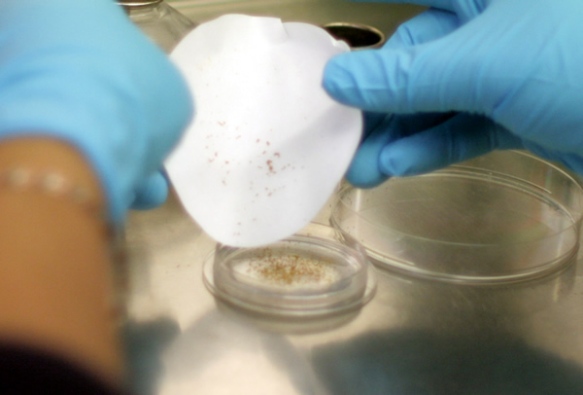
This gallery contains 6 photos.
Despite a winter storm and icy roads, a NASA contracted FedEx vehicle arrived Wednesday to deliver the space flown test and ground control samples to the Ohio University Wyatt Lab.


This gallery contains 6 photos.
Despite a winter storm and icy roads, a NASA contracted FedEx vehicle arrived Wednesday to deliver the space flown test and ground control samples to the Ohio University Wyatt Lab.
 On February 10, 2015, The SpaceX Dragon cargo spacecraft was released from the International Space Station’s robotic arm. The capsule was then maneuvered outside the vicinity of the space station in preparation for its return trip to Earth.
On February 10, 2015, The SpaceX Dragon cargo spacecraft was released from the International Space Station’s robotic arm. The capsule was then maneuvered outside the vicinity of the space station in preparation for its return trip to Earth.
 The SpaceX Dragon cargo spacecraft carrying the Wyatt/ Luesse Labs BRIC-20 space experiment is now berthed to the Harmony module of the International Space Station. The hatch between the newly arrived spacecraft and the Harmony module of the space station is scheduled to be opened today. The capsule will spend four weeks attached to the station before returning to Earth with the Arabidopsis seedlings germinated in space for analysis.
The SpaceX Dragon cargo spacecraft carrying the Wyatt/ Luesse Labs BRIC-20 space experiment is now berthed to the Harmony module of the International Space Station. The hatch between the newly arrived spacecraft and the Harmony module of the space station is scheduled to be opened today. The capsule will spend four weeks attached to the station before returning to Earth with the Arabidopsis seedlings germinated in space for analysis.
For up-to-the-minute news on the mission from space, visit the Space Station Blog.
Also, visit the Wyatt Lab on Facebook for the latest from the scientists supporting the experiment from Earth.
We are happy to announce the Wyatt/ Luesse Labs BRIC-20 space experiment has launched. SpaceX Falcon 9 roared off the pad at Space Launch Complex 40 to place a Dragon cargo capsule on a path to the orbiting laboratory.
To learn more about this launch, read Steven Siceloff’s article “Dragon Begins Cargo-laden Chase of Station.“
 Ready for the Science: The BRIC-20 space experiment has officially cleared the PVT project milestone and is scheduled to launch January 6th, 2014 at 2:31 EDT.
Ready for the Science: The BRIC-20 space experiment has officially cleared the PVT project milestone and is scheduled to launch January 6th, 2014 at 2:31 EDT.
The BRIC-20 experiment will fly aboard the fifth SpaceX Commercial Resupply Services Flight (SpaceX CRS-5). Launching from Cape Canaveral Air Force Station, Florida. SpaceX CRS-5 will deliver cargo and crew supplies to the International Space Station, as well as our Arabidopsis thaliana seeds.
Stay tuned for updates. And in the meantime, you may learn more about the NASA mission here.
How to Send Your Experiment into Space: Anatomy of a Space Experiment
Scientists studying the effects of gravity face the difficulty of designing experiments that isolate the effects of gravity. Ideally, this means conducting an experiment in the absence of gravity – no easy task while on Earth. Certainly, the best place to run a long-term gravity experiment is space or while orbiting the Earth in microgravity conditions; however, getting your experiment into space might be as hard as neutralizing gravity on Earth. This is the dilemma Dr. Sarah Wyatt faced in the search for the genes controlling the signaling pathways of plants responding to changes in gravity.
When NASA Research sent out a call for research proposals for the International Space Station (ISS), Wyatt recognized an opportunity for the Wyatt Lab to take their gravitropism research to the next level. Perhaps you have an experiment you want to run aboard the ISS? Or maybe you just want to know what it takes to get on the ISS research roster. The following briefly describes some of the major milestones in designing and deploying an experiment in space.

Figure 1: NASA BRIC-20 Major Project Milestones

This gallery contains 7 photos.
During the first week of September, the BRIC-20 space experiment moved one big step closer to the December 2014 launch date as members from both the Wyatt Lab (Ohio University) and the Luesse Lab (Southern Illinois University Edwardsville) arrived at … Continue reading
Since beginning work on the NASA sponsored space flight experiment, Wyatt Lab researchers have plated more than 70,000 Arabidopsis seeds. Many of the seeds were hand-counted, and all of them have been used to refine the RNA and protein extraction protocols for seedlings germinated in microgravity environments.

Figure 1: Graduate researcher, Proma Basu, plates seeds in preparation for placement into a simulated BRIC environment. For the space-flown experiment, each plate contains 800 seeds.
Wyatt Lab graduate student researcher, Marilyn Hayden narrates the NASA BRIC-20 de-integration process during science verification testing (SVT) July 28, 2014 at Kennedy Space Center. Continue reading
On July 28, Marilyn Hayden and Zak Hall, Wyatt Lab graduate and undergraduate student researchers assigned to the BRIC-20 NASA research project, took part in de-integration of the experimental materials from the NASA BRIC hardware. Continue reading